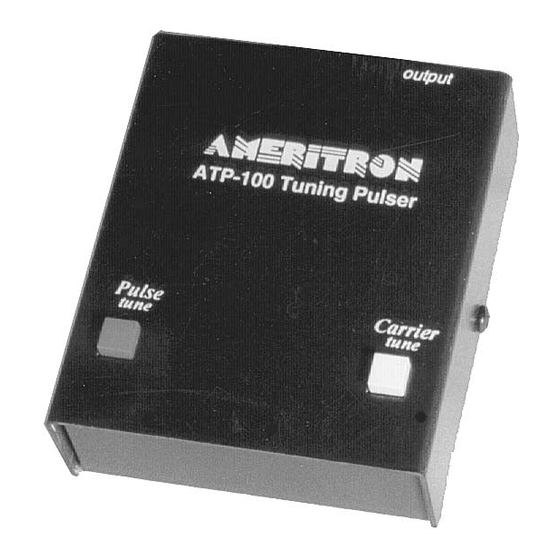AMERITRON ATP-100 Instrukcja obsługi
Przeglądaj online lub pobierz pdf Instrukcja obsługi dla Wzmacniacz AMERITRON ATP-100. AMERITRON ATP-100 8 stron. Tuning pulser

ATP-100 Instruction Manual
Tuning Pulser
Ameritron ATP-100 Tuning Pulser
The Ameritron ATP-100 Tuning Pulser relieves temperature related stress on
amplifiers, tuners, and dummy loads while allowing proper system adjustments.
It allows amplifiers to be properly adjusted without the use of long steady
carriers.
The Ameritron ATP-100 Tuning Pulser allows tuning of an amplifier with full
required drive from the transceiver without over-heating the finals or anything
else in the RF line. It sends a series of pulses to the transceiver allowing the
peak power to be high enough to drive the amplifier to full power, but with the
average power being low enough not to over-heat the final(s).
The Ameritron ATP-100 Tuning Pulser works with any solid state amateur
transceiver or transmitter, and all other equipment using positive keying line
voltages below 50 volts open circuit and 100 mA closed key current. It can also
be used with negative voltage key lines (commonly found in older tube type
radios) provided keying voltages are below 25 volts dc open circuit.
The Ameritron ATP-100 Tuning Pulser can also be used as a valuable
troubleshooting and diagnostic aid. The Ameritron ATP-100 Tuning Pulser can
be used in performance tests of QSK systems, wattmeters, and other equipment
(see appendix).
The Ameritron ATP-100 Tuning Pulser uses a single 9-volt battery for power,
with battery life dependent on operating and storage time. To install the battery
remove the cover by removing the two screws (one on each side) that secure it.
A battery clip and holder, located on the left side of the enclosure, are provided
for installing the 9-volt battery.
Technical Description
The Ameritron ATP-100 Tuning Pulser uses a 555 timer driving an FET open
drain switch. Two internal controls allow independent adjustment of both pulse
repetition rate (PULSE RATE) and on-to-off time duty cycle (DUTY CYCLE).
PULSE RATE is adjustable from about 17 to 40 pulses per second, while DUTY
CYCLE is adjustable from about 10 to 90 percent. The keying time intervals are
typically adjustable from 2- 40 mS "on" time, and a 24 to 60 mS pulse repetition
time interval.
Minimum duty cycle and the slowest PULSE RATE occur at the full
counterclockwise settings of both internal controls. The controls are designed to
accept a small flat blade screwdriver.
1
